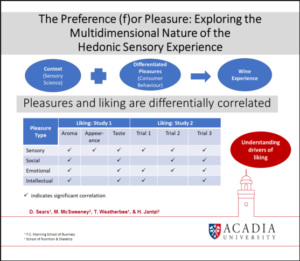The Preference (f)or Pleasure: Exploring the Multidimensional Nature of the Hedonic Sensory Experience
Sears, McSweeney, Weatherbee & Jantzi

Poster presented at the Pangborn Sensory Science Symposium, August 2017
Abstract:
Sensory research has long relied on the use of a 9-point hedonic scale to measure consumers’ liking of food products. Similarly, marketing research in consumer behavior has typically characterized pleasure as an unitary phenomenon. However, consumer behavior research has acknowledged that a multidimensional view is needed to thoroughly explain the experience of pleasure. Recent consumer behavior research also demonstrates that there are four qualitatively different types of pleasure: sensory, social, emotional and intellectual. Exploratory research has developed a 12-item scale that measures the dimensionality of the of the pleasure experienced.
This pilot study applies these techniques in the investigation of the multidimensional view of pleasure to determine whether it is an effective way of understanding the hedonic sensory experience. Since wine is a complex product, it was expected to evoke each of the pleasure types. A consumer panel used the 9-point hedonic scales to the assess aroma, taste, and appearance of the six wines (produced in Nova Scotia, Canada) respectively; the panelists also completed the pleasure scale.
Results demonstrate that the 9-point hedonic and differentiated pleasures scales are significantly but differentially correlated. This suggests reliance on assessing wine attributes solely on a 9-point hedonic scale may cloud our full understanding of the natures of the pleasure experience associated with wine consumption. That is to say, the unidimensional measure of liking or preference fails to capture the multidimensional nature of the experience of pleasure attendant from drinking wine. Consequently, this pilot study provides sufficient empirical justification to continue exploring the relationship between hedonic experience, experienced pleasure, and traditional unidimensional measurement of product attributes.